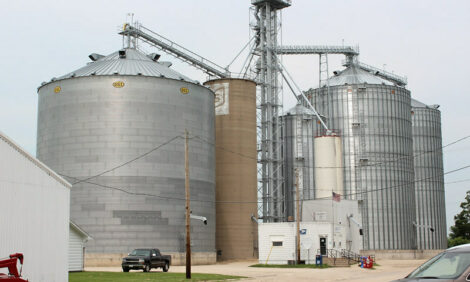



Distiller's Grains Can Contribute To High Performance, Low-Cost Rations
US - Distiller's grains, either wet or dry, can make a valuable contribution to beef cattle diets, regardless of the animals' stage of production. However, there are various factors which need to be considered when determining their potential value in your production system.It is important to understand that during the distillation process, the starch component of cereal grains (normally 60-70%) is fermented out of the grain to ethanol. By removing this fraction, the remaining nutrients are concentrated, roughly, 3-fold. For beef producers this can be beneficial, resulting in an affordable protein supplement containing roughly 30% crude protein. Also, after removal of the starch component and concentration of the fat and fiber fractions, distiller's grains are a good source of energy in the form of digestible fiber and fat.
However, some of the nutrients which become elevated in distiller's grains may limit their potential use in beef cattle diets. The phosphorus content (~0.8-0.9%) of distiller's grains may require the addition of more calcium in order to maintain a proper calcium to phosphorus ratio. Excess phosphorus in the diet will also result in increased excretion in the manure and the associated need to dispose of this phosphorus. Sulfur content of distiller's grains (~0.5-1.2%) may limit their potential use because excessive sulfur in the final diet may cause trace mineral imbalances, health problems, reduced intake, and possibly death.
The fat content of distiller's grains is beneficial to growing and finishing cattle as a concentrated energy source. But excessive fat in the diet of forage-fed animals can reduce forage digestibility resulting in lower net energy consumption and lost body condition.
One additional benefit of feeding distiller's grains in the wet form (WDG) is the conditioning factor this wet ingredient brings to an otherwise dry diet. This may stimulate consumption by growing and finishing cattle, particularly if all the other ingredients in the diet are dry and/or dusty. The moisture added helps tie the loose, fine particles together.
Conversely, dried distiller's grains (DDG) may actually contribute to dustiness of an already dry diet, due to the fine particle size.
A dusty ration may not be palatable, particularly for stressed calves. This dustiness can be alleviated if even a small amount of some other wet ingredient, such as silage, is fed.
Handling is also an important consideration. Wet distiller's grain stored outside during the summer is subject to spoilage within three to five days. If the operation is not large enough to use a full load within this brief time frame, the product can be stored in sealed plastic bags to limit oxygen content and potential of mold development. Another benefit of sealed storage may be to improve the opportunity to purchase an excess supply of wet distiller's grain at a lower price.
Using dried distiller's grains reduces the risk of spoilage, but because of dustiness, they cannot be stored long-term outdoors. Also, due to high fat content, dried distiller's grains may bridge up in a gravity-flow bin. Ideally, the dried product would be stored in a concrete-floored commodity bay.
Variability can be an issue when feeding either the wet or dry product. Particularly, moisture level in wet distiller's grains between loads can vary greatly, affecting the actual amount of dry matter fed. Also, nutrient content may fluctuate over time, between loads, and between suppliers. There are also notable differences in nutrient content between distiller's grains originating from corn, sorghum, or a blend of the two.
In summary, factors to consider when formulating rations with distiller's grains include: protein, fat, phosphorus, sulfur, moisture, and storage options. If these factors are optimized and rations are properly balanced, distiller's grains can contribute to high-performance, low-cost production for beef producers.
TheBeefSite.com News Desk


